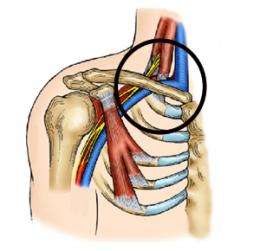Rib fractures linked to circulatory disorder often seen in athletes

(Medical Xpress) -- Surgeons at Washington University School of Medicine in St. Louis have identified tiny fractures and other rib abnormalities in patients treated for a circulatory condition called venous thoracic outlet syndrome.
The findings come from a study of 37 patients who underwent surgery for the syndrome at Barnes-Jewish Hospital.
Also known as subclavian vein effort thrombosis or Paget-Schroetter syndrome, the disorder is often seen in elite athletes who rely on their upper extremities. The hallmark of the syndrome is blockage of the vein that carries blood from the arm to the heart. The vein passes over the first rib and under the collarbone, making it vulnerable to compression, especially under repetitive stress with the arm in an elevated position.
“Most of our patients are young, healthy, physically active people, often athletes,” says Robert W. Thompson, MD, professor of surgery and director of the Center for Thoracic Outlet Syndrome. “And they have a sudden onset of a swollen, bluish arm, sometimes two or three times the normal size.”
In these patients’ first ribs, located under the collarbone, the abnormalities Thompson and his colleagues reported include unusual calcification, degeneration of the rib and even small fractures that cannot be detected by X-ray studies. The study is available online in the Journal of Vascular Surgery.
“If you have repetitive motion of the arm, you may get first-rib microfractures,” Thompson says. “There is often thickening around this rib in response to injury, almost like a callous has formed there. That may take up space and compress the vein. No one has reported this before in patients with thoracic outlet syndrome.”
Once the symptoms are resolved with medication or other methods to break up the blood clot that forms in the compressed and damaged vein, doctors perform surgery to create more space for the vein to pass through and restore blood flow. Part of that surgery involves removal of the entire first rib, which provided Thompson and his colleagues with specimens to examine.
In the 37 patients who underwent surgery in one year at Barnes-Jewish Hospital to treat the syndrome, Thompson found that 16 of the patients had previously undetected fractures in the first rib (43 percent). And of those patients over age 30, 76 percent had rib fractures (16 of 21 patients).
“A surprisingly high percentage of our patients had these microfractures,” Thompson says. “That area of the rib is often quite abnormal in those with venous thoracic outlet syndrome, and it might result from unusual stresses being placed on that rib.”
Venous thoracic outlet syndrome is one of three types of thoracic outlet syndrome (TOS) that Thompson and his team treat. The most common is neurogenic TOS, which is caused by compression of the nerves under the collarbone. Venous TOS is the second most common type, followed by arterial TOS, which involves compression of the subclavian artery, often by a congenital “extra” first rib.
Thompson says that the relatively unique surgical method he uses to treat the venous condition makes Washington University one of the only places in the country where these rib observations could have been made.
“Many times, these operations involve taking the rib out in pieces” he says. “Because we make incisions above and below the collarbone, we can actually remove the entire rib in one piece. Beyond being able to give the patient a nice souvenir, we have the whole rib to examine.”
The nature of the surgery and the fact that the fractures are not visible with non-invasive imaging techniques, such as a CT scan, mean that they were not able to compare these ribs to those of individuals without venous thoracic outlet syndrome.
“We don’t have specimens from the general population,” Thompson says. “But we think these observations would surprise a lot of people. Even if another surgeon operates on patients with venous thoracic outlet syndrome, they likely don’t do the same procedure, and they don’t see the whole rib.”
According to Thompson, treating this relatively uncommon condition in high volume — with patient referrals from across the country — has allowed Washington University surgeons to make new observations about what may be causing it.
More information: Sheng GG, Duwayri YM, Emery VB, Wittenberg AM, Moriarty CT, Thompson RW. Costochondral calcification, osteophytic degeneration, and occult first rib fractures in patients with venous thoracic outlet syndrome. Journal of Vascular Surgery. Online Feb. 10, 2012.


















